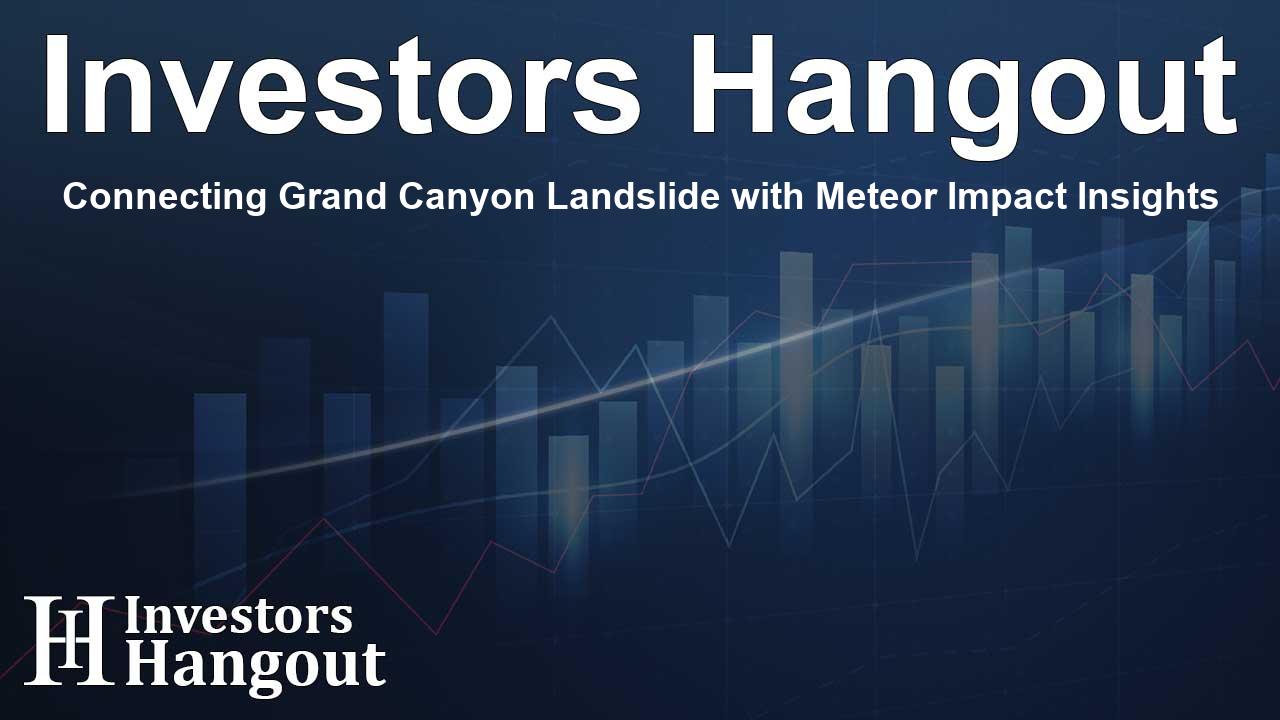Connecting Grand Canyon Landslide with Meteor Impact Insights

Exploring the Link Between the Grand Canyon and Meteor Crater
The recent study offers intriguing insights into a striking geological correlation. It delves into how a significant landslide in the Grand Canyon may have been influenced by the impact of a meteor. This captivating connection not only provides new understanding of ancient geological events but also emphasizes the ongoing importance of studying Earth’s geological history.
The Geological Timeline Unveiled
Researchers at the University of New Mexico and the University of Arizona, alongside the Lunar and Planetary Institute, have spearheaded this exciting research. They focus on the ages of notable geological phenomena, showing how both the Grand Canyon landslide and the Meteor Crater impact occurred around the same period, approximately 56,000 years ago. This discovery raises questions about how these majestic landscapes have evolved over time.
Evidence Found in Stanton's Cave
In Marble Canyon, the presence of ancient driftwood and sediments in Stanton's Cave posed an enigma. Positioned significantly above the Colorado River, the question arises: how did these materials arrive at such heights? The hypothesis indicates that a massive flood or perhaps the formation of a paleolake could explain their presence, making them pivotal to understanding historical flood patterns in the region.
Scientific Investigations and Technological Advances
The path to uncovering these geological secrets involved advances in scientific methods and collaborative efforts across generations of researchers. Initial findings in the 1960s hinted at ancient ecosystems but were limited by the technology of the time. The recent study utilized cutting-edge dating techniques that pushed the age of the driftwood to an astounding 56,000 years, matching the age of the meteor impact site.
Impacts of the Meteor Event on Geological Structures
David Kring, a prominent researcher in the field, has made significant contributions in correlating the two events. Extensive analysis indicates that the shock waves from the meteor impact may have created substantial seismic activity, resulting in a landslide that blocked the Colorado River, thus generating a vast paleolake that flooded certain cave systems.
Understanding Future Geological Hazards
This research does more than just shed light on past events; it also drives home the significance of preparing for future geological hazards. Landslides in mountainous territories can pose serious risks to communities and change landscapes dramatically. This revelation adds an essential layer to our comprehension of geological safety in mountainous regions, reinforcing the need for ongoing research.
Community Awareness and Safety
As our understanding deepens, so too does the importance of educating local communities about the implications of geological events. This study emphasizes awareness of how historical impacts inform current geological risks, which is crucial for community preparedness against potential disasters.
The Broader Scientific Community's Role
The collaborative nature of this research is a testament to the power of teamwork in science. This international project brought together experts from various fields, showing how interdisciplinary cooperation is vital in pursuing comprehensive geological understanding. The research extends beyond just the mechanics of the impacts but also into future exploration endeavors.
Inspiring Future Research
As we glean insights from the Grand Canyon and Meteor Crater, these findings may catalyze further investigations. Understanding impact events contributes not only to geoscience but also has implications for astronaut safety in space exploration, highlighting the interconnectedness of earthly and cosmic phenomena.
Frequently Asked Questions
What is the significance of the Grand Canyon landslide study?
This study connects two significant geological events, enhancing our understanding of Earth’s geological history and future hazards.
How are the Grand Canyon and Meteor Crater related?
Both share a similar age of 56,000 years, suggesting that the meteor impact may have caused the landslide that formed a paleolake in the Grand Canyon.
What were the findings regarding Stanton's Cave?
Evidence found in Stanton's Cave indicates ancient driftwood and sediments, raising questions about their origins and the geological events that led to their presence.
What risks do ancient impact events pose today?
Understanding past impact events helps assess current geological hazards, especially landslides, which can disrupt communities and reshape landscapes.
How does this research contribute to future science and exploration?
By exploring impacts on Earth, scientists can better prepare for potential hazards in future exploration missions, including those related to lunar and planetary studies.
About The Author
Contact Thomas Cooper privately here. Or send an email with ATTN: Thomas Cooper as the subject to contact@investorshangout.com.
About Investors Hangout
Investors Hangout is a leading online stock forum for financial discussion and learning, offering a wide range of free tools and resources. It draws in traders of all levels, who exchange market knowledge, investigate trading tactics, and keep an eye on industry developments in real time. Featuring financial articles, stock message boards, quotes, charts, company profiles, and live news updates. Through cooperative learning and a wealth of informational resources, it helps users from novices creating their first portfolios to experts honing their techniques. Join Investors Hangout today: https://investorshangout.com/
The content of this article is based on factual, publicly available information and does not represent legal, financial, or investment advice. Investors Hangout does not offer financial advice, and the author is not a licensed financial advisor. Consult a qualified advisor before making any financial or investment decisions based on this article. This article should not be considered advice to purchase, sell, or hold any securities or other investments. If any of the material provided here is inaccurate, please contact us for corrections.
